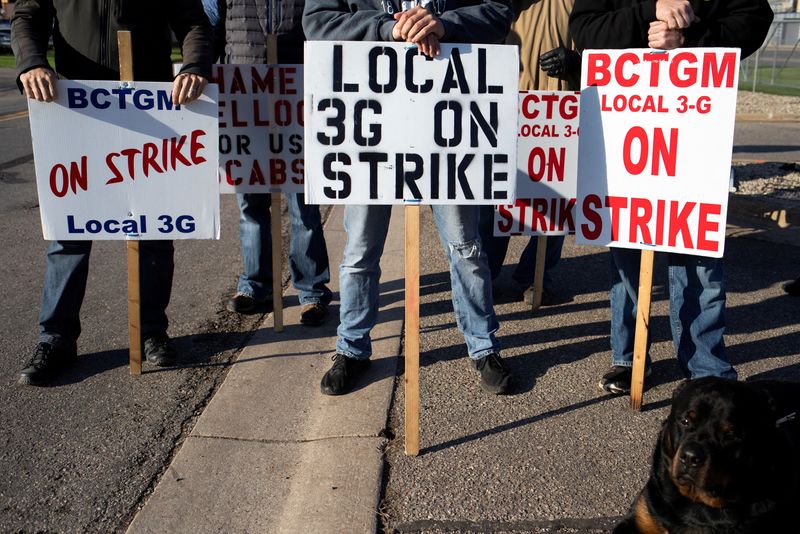By John Kruzel
WASHINGTON (Reuters) - The U.S. Supreme Court has delivered the latest in a series of rulings undercutting organized labor, with some legal experts predicting that the decision will make unions that engage in strikes more vulnerable to lawsuits while others see a more modest impact.
An 8-1 ruling on Thursday authored by conservative Justice Amy Coney Barrett made it easier for companies to sue over strikes that cause certain instances of property damage. The case involved a strike by the union representing truck drivers at a concrete business owned by Japan-based Taiheiyo Cement Corp in Washington state.
Some experts viewed the ruling as consistent with the conservative-majority court's history in recent years of restricting union and employee rights.
Angela Cornell, a Cornell Law School labor law professor, called it "another decision that undermines the capacity of unions to function."
"Weakening the right to strike by making it riskier to exercise means it will reduce the only leverage unions have when negotiating with companies. This, of course, is a big tilt toward business interests and against the collective interests of workers," said Cornell, who joined a brief supporting the union in the case.
"The decision is part of a systematic project by the Supreme Court to limit employee collective rights in the name of industrial peace while expanding employer weapons of lockouts and permanent replacements in the name of private property rights and free enterprise," added Indiana University Maurer School of Law labor and employment law professor Kenneth Dau-Schmidt, who also joined a brief backing the union.
But according to Harvard Law School professor of labor and industry Benjamin Sachs, if lower courts faithfully apply the reasoning detailed in Barrett's decision then it "won't do much damage to the right to strike."
"The court issued a very narrow holding that appears to be limited to the specific facts of a case involving the specific nature of concrete mixing," Sachs said.
The court ruled in favor of Glacier Northwest Inc, which sued a local affiliate of the International Brotherhood of Teamsters after a work stoppage forced the company to discard undelivered concrete. The justices ruled that the company's claims were not preempted by a statute called the National Labor Relations Act on the grounds that the union had failed to take "reasonable precautions" to prevent a foreseeable and imminent harm to the employer's property resulting from the strike.
MORE STRIKES
The ruling comes at a time of increasing strikes called by U.S. labor unions. According to U.S. Bureau of Labor Statistics data, the number of American workers who participated in strikes and similar activities in 2022 increased by nearly 50% compared to the previous year.
Cornell said the decision "could chill the recent uptick in collective action by workers" by placing unions at greater risk of facing lawsuits if they go on strike.
Dan Altchek, an attorney at the Philadelphia-based firm Saul Ewing who represents employers in labor matters, said the ruling gives employers "a bit of a roadmap" for how to reduce the odds of lawsuits over strike-related property damage from being dismissed.
"If and when such lawsuits survive a union's motion to dismiss, the litigation risk for the union resulting from the strike is significantly enhanced," Altchek added.
Some experts pointed out that the ruling largely preserved the existing legal scaffolding for deciding labor law preemption cases of this kind.
"The court's analysis may have modestly lowered the union-protection threshold in considering applicability or scope of the 'take reasonable precautions' test," said James Brudney, a Fordham University Law School professor of labor and employment law.
Brudney called this aspect of the ruling a "relatively minor development" compared to the court's broader decision to leave intact its major framework for analyzing labor disputes of this nature.
The Supreme Court, with its 6-3 conservative majority, has dealt setbacks to organized labor in key cases in recent years.
In 2021, it struck down a California agricultural regulation aimed at helping unions organize workers. In 2018, it ruled that non-members cannot be forced, as they are in certain states, to pay fees to unions representing public employees such as police and teachers that negotiate collective bargaining agreements with employers.
Brudney said Thursday's ruling "was not comparable to that broader trendline" of decisions weakening labor unions.

West Virginia University College of Law professor Anne Marie Lofaso said, "The case fits into the judicial trend to weaken labor unions by weakening what counts as protected concerted activity."
"This was the narrowest analysis that the court could have done to allow the employer to win," Lofaso added.